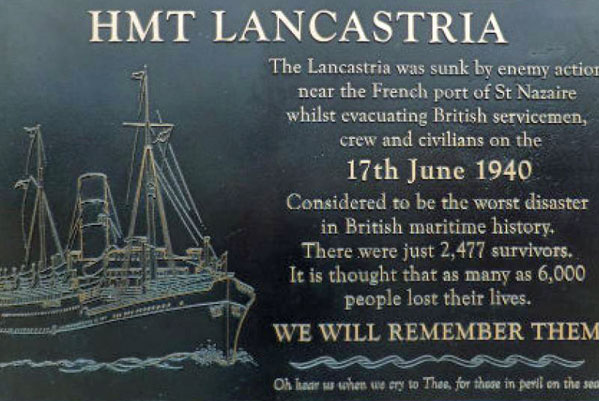The 80th anniversary of the sinking of the Cunard liner, HMT Lancastria, reckoned to be Britain's worst ever maritime disaster, falls on the 17th June 2020.
On that date in 1940, the ship was lying off the French port Nazaire, as a transport vessel, waiting to embark British troops and civilians, who, left behind after the Dunkirk evacuation, had been instructed to move west ahead of advancing German forces. While at anchor the ship was bombed by the Luftwaffe and sank, with the reported loss of over 4000 men, women and children. Some sources put the loss of life much higher, with less than 2,500 surviving the bombing and strafing by German aircraft.
Loss of life exceeded that from the Titanic and Lusitania combined. Following Dunkirk, news of this evacuation and its disastrous end was suppressed by Churchill for fear of the adverse effect on public morale, the reports leaking out some weeks later in the USA. It was some time too, before some bodies washed ashore south along the French coast, the remains to be buried in the nearest public cemeteries and the news of the losses filtering back over time to relatives.

The memorial plaque at Liverpool's Pier Head
The ship was built on the Clyde and at the 75th anniversary of the disaster, the Scottish government, after sustained campaigning by the Lancastria Association of Scotland, struck a Lancastria medal for presentation to survivors and relatives and erected a memorial on the site of William Beardmore's shipyard at Clydeside.
A victim list, (www.lancastria.org.uk/victim-list) includes the mention of the Royal Ulster Rifles and in particular one Alexander Wright aged 33, 2nd battalion RUR, buried at Le Clion-sur-Mer, about 30 miles south of Saint Nazaire. Given the overall number of victims, it appears possible that others from Ulster (and possibly local to us) could have been lost and/or buried, but the writer has thus far concentrated on his own family research, resulting in the discovery of his English uncle's resting place in the cemetery at Prefailles, also about 30 miles south of Saint Nazaire. He too was one of the many victims whose bodies drifted south and were washed ashore some time after the event, and he will be remembered on 17th June.
Looking further afield at the stories of the losses of other well-known Cunard-White Star Line ships, some are found to have some connection with Ireland.
Lusitania was torpedoed off Kinsale in 1915 with the loss of 1198 lives, Laurentic was lost off Donegal with the loss of 49 lives and Carpathia, the ship that attended Titanic, was sunk by torpedo on 15th July 1918, in the southern approaches.
Closer to home, the Titanic story is well known, as is that of the Nomadic, which, at one time before restoration, was looked after by staff employed by Bangor-based Quay Marinas Limited and afterwards by a Management Board including two Bangor residents. In connection with the 90th anniversary of Titanic's loss, North Down Borough Council had planned commemorative events. Artist ED Walker was commissioned to portray the ship passing Bangor on her sea trials. A limited edition of 1593 signed prints reflecting the number of souls lost, was produced. (The writer has one, No 139 - current value about £60.00 - same as the cost of framing).
A further, more tenuous, connection exists right on Bangor's Eisenhower Pier, where a cardinal buoy rests as a fund- raising collecting box for the RNLI's support of their volunteers in saving lives at sea. The plaque on the buoy outlines its history and states its last location as marking Tayleur Rock close to Lambay Island near Malahide.
It tells us of the loss of the ship Tayleur, with 652 passengers and crew on board, en-route from Liverpool to Melbourne on her maiden voyage and the resulting name of the rock upon which it stranded on 21st January, 1854, with the loss of 380 men women and children.
The ship, on charter to Cunard, was later called the "first Titanic". The cause of the loss was reported as inaccurate compasses - Squire Lecky was still an apprentice at that time and subsequently a commemorative medal was struck.
There are publications available for the detailed stories of all these disasters.
